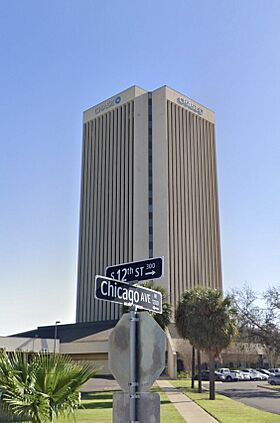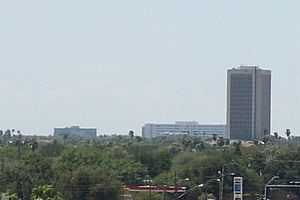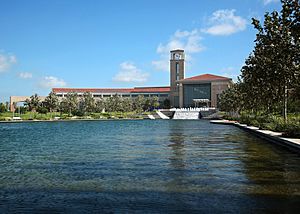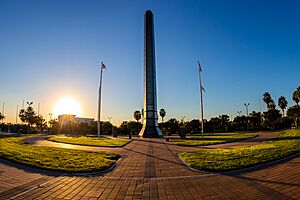McAllen, Texas facts for kids
Quick facts for kids
McAllen
|
|
|---|---|
|
Images, from top down, left to right: Chase Bank Tower in downtown McAllen; Interior of the Quinta Mazatlan; McAllen Convention Center at night; McAllen Performing Arts Center; Entrance to McAllen Public Library
|
|
| Nickname(s):
"The City of Palms"
|
|
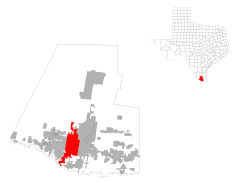
Location within Hidalgo County
|
|
| Country | United States |
| State | Texas |
| County | Hidalgo |
| Founded | December 5, 1904 |
| Incorporated | February 20, 1911 |
| Government | |
| • Type | Council-Manager |
| Area | |
| • City | 62.73 sq mi (162.48 km2) |
| • Land | 62.31 sq mi (161.37 km2) |
| • Water | 0.43 sq mi (1.11 km2) |
| Elevation | 121 ft (37 m) |
| Population
(2020)
|
|
| • City | 142,210 |
| • Estimate
(2022)
|
144,579 |
| • Rank | US: 190th TX: 23rd |
| • Density | 2,320/sq mi (895.9/km2) |
| • Urban | 779,553 (US: 56th) |
| • Urban density | 2,389.7/sq mi (922.7/km2) |
| • Metro | 888,367 (US: 65th) |
| Time zone | UTC–6 (Central (CST)) |
| • Summer (DST) | UTC–5 (CDT) |
| ZIP codes |
78501, 78502, 78503, 78504, 78505, 78539, 78557, 78572
|
| Area code(s) | 956 |
| Sales Tax | 8.25% |
| GNIS feature ID | 1374829 |
McAllen is a city in Texas, a state in the United States. It is the biggest city in Hidalgo County. McAllen is located at the very southern tip of Texas, right in the Rio Grande Valley. It sits on the border with Mexico, across the Rio Grande river from the Mexican city of Reynosa.
McAllen is about 70 miles (113 km) west of the Gulf of Mexico. In 2020, about 142,210 people lived in McAllen, making it the 23rd largest city in Texas. It is also part of a larger metropolitan area called McAllen–Edinburg–Mission, which is the fifth largest in Texas. The area that includes both McAllen and Reynosa has over 1.5 million people.
When McAllen was first settled in 1904, it was mostly a farming area. But in the second half of the 1900s and into the 2000s, the city and its surrounding areas grew a lot. The growth of factories that assemble products (called maquiladora) and the North American Free Trade Association (NAFTA) agreement helped increase trade between McAllen and Mexico.
Contents
A Look at McAllen's Past
In 1904, a railroad line reached the Santa Anita Ranch. John McAllen and his son, James, gave land to the railroad company so the tracks would go through the area. On December 5, 1904, the McAllen Townsite Company was started. The new town was named after John McAllen. It had the closest train station to the county seat, Hidalgo, which was eight miles south.
By 1911, about 5,000 acres of land in East McAllen were being farmed. Farmers grew cotton, citrus fruits, and other crops. East McAllen had about 1,000 people that year. In 1911, the town officially became a city and was named McAllen. In 1916, 20,000 soldiers from New York were sent to McAllen to help with problems along the border. This brought a lot of money and people to the town. The population grew from 1,200 in 1916 to 6,000 in 1920.
McAllen adopted its own city rules in 1927. Factories that made canned goods, a winery, and oil exploration helped the population grow to 9,074 by 1930. In 1936, a distillery opened that made wines from citrus juices. By 1940, McAllen was a center for farming and oil, with 11,877 people. It also got its nickname, "The City of Palms."
In 1941, a new suspension bridge was built to Reynosa, Tamaulipas, Mexico. This bridge, later called the McAllen-Hidalgo-Reynosa International Bridge, brought more tourists to McAllen. It became a popular winter vacation spot and a way to enter Mexico. In 1947, oil was found near Reynosa, which led to many people moving there from other parts of Mexico. This created more tourists and trade between McAllen and Reynosa. The population of McAllen grew to 20,005 in 1950 and 32,728 in 1960.
By 1970, McAllen was a hub for farming, oil, and tourism, with a population of 37,636. The city had a 200-bed hospital and a new air-conditioned high school. Tourism continued to grow. The population reached 66,281 by 1980. In the late 1980s, the McAllen Foreign Trade Zone became important. This is an area where goods can be brought in without paying taxes right away, which helps businesses.
In the mid-1980s, the economy in Hidalgo County started to get better. This was thanks to trade and the growth of maquiladoras. These are factories where parts are sent to Mexico, put together, and then sent back. McAllen is right across the border from Reynosa, which is a big manufacturing city. It became easier to get companies to build their factories in Mexico with support offices in Texas.
Where is McAllen?
McAllen is located at 26°12′59″N 98°14′11″W / 26.21639°N 98.23639°W. The city covers about 46.3 square miles (120 square kilometers). Most of this area is land, with a small amount of water.
Even though McAllen is called the City of Palms, you won't see tropical plants everywhere. The area has many thorny shrubs and trees that lose their leaves, like Rio Grande Ash, Cedar Elm, and Honey Mesquite.
Who Lives in McAllen?
| Historical population | |||
|---|---|---|---|
| Census | Pop. | %± | |
| 1910 | 150 | — | |
| 1920 | 5,331 | 3,454.0% | |
| 1930 | 9,074 | 70.2% | |
| 1940 | 11,877 | 30.9% | |
| 1950 | 20,067 | 69.0% | |
| 1960 | 32,728 | 63.1% | |
| 1970 | 37,636 | 15.0% | |
| 1980 | 66,281 | 76.1% | |
| 1990 | 89,000 | 34.3% | |
| 2000 | 106,414 | 19.6% | |
| 2010 | 129,877 | 22.0% | |
| 2020 | 142,210 | 9.5% | |
| 2022 (est.) | 144,579 | 11.3% | |
| U.S. Decennial Census 2020 Census |
|||
Population in 2020
In 2020, McAllen had 142,210 people living in the city. There were 45,429 households and 34,119 families.
Most people in McAllen are of Hispanic or Latino background. In 2020, about 86.7% of the population identified as Hispanic or Latino.
Population in 2010
In 2010, there were 129,877 people in McAllen. About 84.6% of the people were Hispanic or Latino.
Of the households, 46% had children under 18 living with them. The average household had 3.10 people. The average family had 3.58 people.
About 30.1% of the population was under 18 years old. The average age in the city was 32.2 years.
McAllen's Economy
The Rio Grande Valley started to grow quickly after irrigation was introduced in 1898 and the railroad was built in 1904. These changes turned the area into a major farming center. For much of the 1900s, McAllen's economy was based on farming.
Today, McAllen is becoming a big center for international trade. It is also important for healthcare, shopping, and tourism. In 2012, the average cost of a home in McAllen was one of the lowest in the country. The cost of living in McAllen was also lower than the national average.
Trade and Business
Since the 1980s, and especially after the North American Free Trade Agreement (NAFTA) in 1994, McAllen's economy has focused more on international trade, healthcare, shopping, and tourism.
The McAllen Foreign-Trade Zone (FTZ) is located between McAllen and Reynosa. It was the first inland foreign-trade zone in the United States, started in 1973. In an FTZ, products can be brought in without paying taxes right away. This helps businesses save money. The FTZ also offers services like warehousing and inventory control.
Sports in McAllen
McAllen has hosted important football championships in the past. These included the NAIA National Football Championship in the late 1970s and NCAA Division II national football championship games in the 1980s.
Until 2014, McAllen was home to a baseball team called the Texas Thunder. They were part of the independent United League Baseball.
Fun Things to Do in McAllen
Nature and Birdwatching
McAllen is on a major flyway, which is a path birds use when they migrate between North and South America. This makes it a great place for watching birds and butterflies. The area has many different kinds of wildlife.
- The Quinta Mazatlan is a historic Spanish colonial mansion. It is part of the World Birding Center and a great spot for birdwatching.
- The McAllen Nature Center is another popular place for nature lovers. It has walking trails, a small hill, and a cactus garden. Admission is free!
Parks and Recreation
- The Bicentennial Bike Path is a long path for biking that runs through the city.
- The International Museum of Art & Science (IMAS) is located near the bike path. It is a museum that works with the Smithsonian.
- The Zinnia Spray Water Park is McAllen's first splash pad park. It's a fun place to cool off.
- The Champion Lakes Golf Course has 18 holes and a driving range. Many tournaments are held here.
- The McAllen Dog Park is a great place for dog owners to let their pets run around. It has two separate sections.
Getting Around McAllen
Public Transportation
Metro McAllen provides public transportation for the city. It started in 1997 and now has 12 bus routes. It also offers paratransit services for people with disabilities. Metro McAllen buses run seven days a week.
Downtown Bus Terminal
The city also runs the McAllen Central Station in downtown McAllen. This is a main hub for Metro McAllen and for 14 private bus lines that travel within the U.S. and to Mexico. About 60 buses leave from Central Station every day.
Major Roads
Several important highways go through McAllen:
 Interstate 2
Interstate 2 U.S. 83 is the main east-west road.
U.S. 83 is the main east-west road. State Highway 107
State Highway 107 State Highway 336
State Highway 336 State Highway 495
State Highway 495 Interstate 69C
Interstate 69C
Air Travel
McAllen Miller International Airport offers flights to several major cities. You can fly to places like Dallas/Fort Worth, Houston, Mexico City, Austin, Las Vegas, Los Angeles, and Orlando-Sanford from this airport.
Learning in McAllen
Colleges and Universities
- South Texas College has its main campus in McAllen. It has over 27,000 students across its campuses and online programs.
Schools for Kids
Most of McAllen is served by the McAllen Independent School District. Other parts of the city are served by the Valley View Independent School District, the Sharyland Independent School District, the Edinburg Consolidated Independent School District, the Hidalgo Independent School District, and the Pharr-San Juan-Alamo Independent School District.
Students can also apply to special magnet schools run by the South Texas Independent School District. There is also a private Catholic school, Our Lady of Sorrows School.
Public Libraries
The McAllen Public Library has a main library and two branches. The new Main Library opened in 2011 inside a building that used to be a Walmart store. It won an award for its interior design!
Arts and Culture
The International Museum of Art & Science (IMAS) was founded in 1967. It is a museum that works with the Smithsonian and is located in McAllen.
Media in McAllen
Television Stations
McAllen and the surrounding area have many television stations, including:
- KGBT-TV 4 (Independent)
- KRGV-TV 5 (ABC)
- KVEO 23 (NBC/CBS)
- KTFV-CD 32 (UniMás)
- KTLM 40 (Telemundo)
- KNVO 48 (Univision)
- KFXV 60 (FOX)
- KMBH-LD 67 (FOX)
Radio Stations
There are many radio stations in McAllen, playing different types of music and news, in both English and Spanish. Some examples include:
- KURV 710 AM (News Talk Radio)
- KFRQ Q94.5 FM (Rock)
- KVMV 96.9 FM (Christian)
- KTEX 100.3 FM (Country)
- KBFM Wild 104.1 FM (Hip-Hop/R&B)
Newspapers
The main newspapers in the area are:
- The Monitor
- Valley Morning Star
Cool Buildings and Places to See
Tallest Buildings
| Rank | Building | Height |
|---|---|---|
| 1 | Chase Neuhaus Tower | 17 Floors |
| 2 | PNC Bank Building | 11 Floors |
| 3 | Bentsen Tower | 11 Floors |
| 4 | DoubleTree Suites by Hilton Hotel | 9 Floors |
| 5 | McAllen Medical Center | 8 Floors |
| 6 | Inter National Bank | 6 Floors |
City Districts
McAllen has several interesting districts:
- Downtown McAllen
- De Palmas Historic District
- 17th Street Entertainment District
- McAllen Arts District
- Uptown McAllen
- McAllen Convention Center District
Points of Interest
- McAllen Botanical Gardens
- Quinta Mazatlan
- McAllen Convention Center
- La Plaza Mall
- International Museum of Art & Science
- Historic Cine El Rey Theatre
- Veteran's War Memorial of Texas
Famous People from McAllen
Many notable people have connections to McAllen:
- Cristela Alonzo: A comedian and actress.
- Abraham Ancer: A professional golfer.
- Viola Canales: A writer and law lecturer.
- Jorge Cantú: A baseball player.
- Shaine Casas: A competitive swimmer.
- Raúl Castillo: An actor.
- Michael Cole: A professional wrestling commentator.
- Ana Brenda Contreras: A Mexican-American actress and singer.
- Henry Cuesta: A clarinet player on The Lawrence Welk Show.
- Catherine Hardwicke: A film director who grew up in McAllen.
- Carl Möhner: An actor, director, and painter.
- James Nicholas Rowe: A colonel in the United States Army.
- Gladys Tamez: A famous hat designer.
- Gloria Trevi: A Mexican pop star who lives in McAllen.
Sister Cities
McAllen has several sister cities, mostly in Mexico. This helps build friendly relationships and cultural exchange between the cities.
 Cadereyta Jiménez, Mexico
Cadereyta Jiménez, Mexico Chilpancingo de los Bravo, Mexico
Chilpancingo de los Bravo, Mexico Ciudad Victoria, Mexico
Ciudad Victoria, Mexico García, Mexico
García, Mexico Guadalupe, Mexico
Guadalupe, Mexico Irapuato, Mexico
Irapuato, Mexico Monterrey, Mexico
Monterrey, Mexico Reynosa, Mexico
Reynosa, Mexico San Luis Potosí, Mexico
San Luis Potosí, Mexico Tampico, Mexico
Tampico, Mexico Taxco de Alarcón, Mexico
Taxco de Alarcón, Mexico Zihuatanejo de Azueta, Mexico
Zihuatanejo de Azueta, Mexico
See also
 In Spanish: McAllen para niños
In Spanish: McAllen para niños


